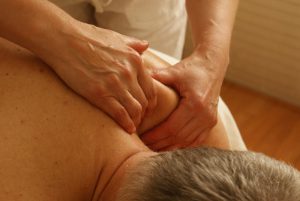Sports Massage
Why Get A Sports Massage?
Sports massage is a good choice if you have a specific problem, such as tennis elbow or sore knees from running or biking.

Sports massage has developed over the years to help athletes prepare their bodies for optimal performance, to function well during training, and/or recover after a big event. Emphasizing prevention and healing of injuries.
Sports Massage is wonderful for athletes, though you don’t have to be an athlete to benefit from sports massage. It is also good for people with injuries, chronic pain or restricted range of motion. Massage therapists generally concentrate on a specific problem area you have requested, most likely associated with sports activity of some kind, such as running, tennis, or golf. The therapist generally focuses in on the problem area—a frozen shoulder or a pulled hamstring, for instance—rather than giving you a full-body massage.
The most important thing with sports massage is that you find a specially trained massage therapist. One who has mastery of a wide range of techniques and knows when to use them. Sometimes men who are new to massage are more comfortable getting a sports massage because it sounds more masculine. That’s fine, even if they don’t have an injury. No matter what type of massage you choose, the therapist should check in with you about what your needs and expectations are for the massage. Many spas used to put sports massage on their menu as a way to appeal to men. As spas have become more sophisticated, however, they realize they don’t list sports massage unless they have therapists with specialized training. If sports massage isn’t listed, an alternative is to explain your objective and ask for a therapist who can achieve that.
What Happens During A Sports Massage?
Sports massage therapists will use a variety of techniques to achieve the desired goal.

There are four types of sports massages:
- Pre-event sports massage: a short, stimulating massage 15-45 minutes before the event. It is directed toward the parts of the body that will be involved in the exertion.
- Post-event sports massage: given within an hour or two of the event, to normalize the body’s tissues.
- Restorative sports massage: given during training to allow the athlete to train harder and with less injury.
- Rehabilitative sports massage: aimed at alleviating pain due to injury and returning the body to health.
The therapist may use Swedish massage to stimulate circulation of blood and lymph fluids, and trigger point therapy to break down adhesions (knots in the muscles), and stretching to increase the range of motion. The therapist should also have a good foundation in hydrotherapy modalities including cryotherapy and thermotherapy, which can help with recovery, repair and healing processes. It may also be a good idea to see a movement therapist, who can help you identify and correct the movement pattern that might be causing your injury in the first place.
Sports massage can be an interesting career choice for therapists who want to do it full time. Professional sports teams often have massage therapists on staff to keep athletes’ bodies working at their very best. It helps to have a keen interest in anatomy and physiology, advanced training and experience in sports massage, an interest in sports, and a desire to work with athletes.
Book your Sports Massage with Zen Massage @ http://zenmassage.net/
